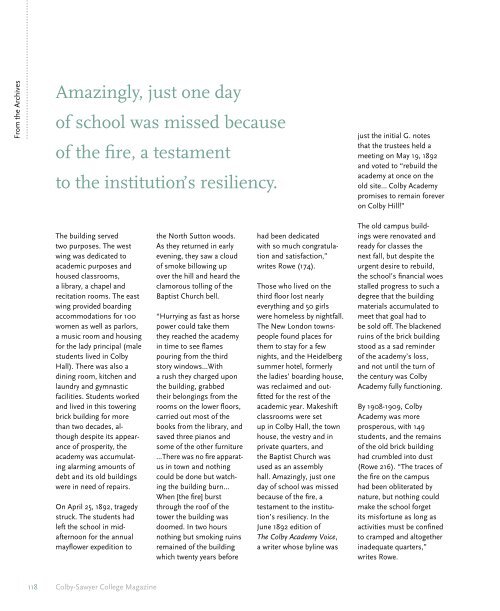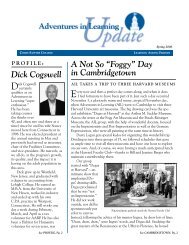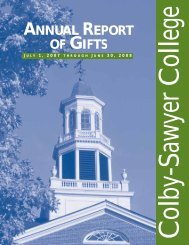Fall 2012 Issue - Colby-Sawyer College
Fall 2012 Issue - Colby-Sawyer College
Fall 2012 Issue - Colby-Sawyer College
You also want an ePaper? Increase the reach of your titles
YUMPU automatically turns print PDFs into web optimized ePapers that Google loves.
From the Archives<br />
Amazingly, just one day<br />
of school was missed because<br />
of the fire, a testament<br />
to the institution’s resiliency.<br />
The building served<br />
two purposes. The west<br />
wing was dedicated to<br />
academic purposes and<br />
housed classrooms,<br />
a library, a chapel and<br />
recitation rooms. The east<br />
wing provided boarding<br />
accommodations for 100<br />
women as well as parlors,<br />
a music room and housing<br />
for the lady principal (male<br />
students lived in <strong>Colby</strong><br />
Hall). There was also a<br />
dining room, kitchen and<br />
laundry and gymnastic<br />
facilities. Students worked<br />
and lived in this towering<br />
brick building for more<br />
than two decades, although<br />
despite its appearance<br />
of prosperity, the<br />
academy was accumulating<br />
alarming amounts of<br />
debt and its old buildings<br />
were in need of repairs.<br />
On April 25, 1892, tragedy<br />
struck. The students had<br />
left the school in midafternoon<br />
for the annual<br />
mayflower expedition to<br />
118 <strong>Colby</strong>-<strong>Sawyer</strong> <strong>College</strong> Magazine<br />
the North Sutton woods.<br />
As they returned in early<br />
evening, they saw a cloud<br />
of smoke billowing up<br />
over the hill and heard the<br />
clamorous tolling of the<br />
Baptist Church bell.<br />
“Hurrying as fast as horse<br />
power could take them<br />
they reached the academy<br />
in time to see flames<br />
pouring from the third<br />
story windows…With<br />
a rush they charged upon<br />
the building, grabbed<br />
their belongings from the<br />
rooms on the lower floors,<br />
carried out most of the<br />
books from the library, and<br />
saved three pianos and<br />
some of the other furniture<br />
...There was no fire apparatus<br />
in town and nothing<br />
could be done but watching<br />
the building burn…<br />
When [the fire] burst<br />
through the roof of the<br />
tower the building was<br />
doomed. In two hours<br />
nothing but smoking ruins<br />
remained of the building<br />
which twenty years before<br />
had been dedicated<br />
with so much congratulation<br />
and satisfaction,”<br />
writes Rowe (174).<br />
Those who lived on the<br />
third floor lost nearly<br />
everything and 50 girls<br />
were homeless by nightfall.<br />
The New London townspeople<br />
found places for<br />
them to stay for a few<br />
nights, and the Heidelberg<br />
summer hotel, formerly<br />
the ladies’ boarding house,<br />
was reclaimed and outfitted<br />
for the rest of the<br />
academic year. Makeshift<br />
classrooms were set<br />
up in <strong>Colby</strong> Hall, the town<br />
house, the vestry and in<br />
private quarters, and<br />
the Baptist Church was<br />
used as an assembly<br />
hall. Amazingly, just one<br />
day of school was missed<br />
because of the fire, a<br />
testament to the institution’s<br />
resiliency. In the<br />
June 1892 edition of<br />
The <strong>Colby</strong> Academy Voice,<br />
a writer whose byline was<br />
just the initial G. notes<br />
that the trustees held a<br />
meeting on May 19, 1892<br />
and voted to “rebuild the<br />
academy at once on the<br />
old site… <strong>Colby</strong> Academy<br />
promises to remain forever<br />
on <strong>Colby</strong> Hill!”<br />
The old campus buildings<br />
were renovated and<br />
ready for classes the<br />
next fall, but despite the<br />
urgent desire to rebuild,<br />
the school’s financial woes<br />
stalled progress to such a<br />
degree that the building<br />
materials accumulated to<br />
meet that goal had to<br />
be sold off. The blackened<br />
ruins of the brick building<br />
stood as a sad reminder<br />
of the academy’s loss,<br />
and not until the turn of<br />
the century was <strong>Colby</strong><br />
Academy fully functioning.<br />
By 1908-1909, <strong>Colby</strong><br />
Academy was more<br />
prosperous, with 149<br />
students, and the remains<br />
of the old brick building<br />
had crumbled into dust<br />
(Rowe 216). “The traces of<br />
the fire on the campus<br />
had been obliterated by<br />
nature, but nothing could<br />
make the school forget<br />
its misfortune as long as<br />
activities must be confined<br />
to cramped and altogether<br />
inadequate quarters,”<br />
writes Rowe.









